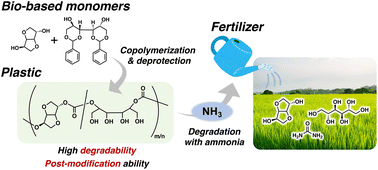Plastics to fertilizer: guiding principles for functionable and fertilizable fully bio-based polycarbonates†
Abstract
Nowadays, commodity polymers are required to be environmentally friendly due to resource depletion and the still low recycling rates associated with plastics, which has promoted the development of circular materials systems. Poly(isosorbide carbonates) (PICs), i.e., bio-based polycarbonates synthesized from non-toxic and biodegradable isosorbide (ISB), which is derived from glucose, have attracted substantial interest as an alternative to conventional petroleum-based polymers on account of their superior thermal stability and transparency. Recently, we have established a novel concept in which PICs are used as a source of fertilizer after treatment with ammonia. PICs can be degraded by ammonolysis to give a mixture of isosorbide and urea, which can be directly used as a fertilizer, i.e., PICs are used not only as a promising engineering plastic, but also as a fertilizer source, leading to innovative chemical recycling systems that provide solutions to the global food-production problem on account of the ever-increasing human population. In this study, a modification method that endows PICs with further functions and/or tunable properties is introduced in order to establish a guiding principle for the design of materials based on PICs. Namely, we focused on 1,3:4,6-di-O-benzylidene-D-mannitol (DBM), which contains two hydroxy groups and two acetal structures, and is synthesized from D-mannitol. DBM was successfully copolymerized with ISB to afford fully bio-based polycarbonates with a thermal stability that is comparable to that of conventional petroleum-based polycarbonates. The characteristics of the resulting polymers were easily modified by deprotection of the acetal group on the DBM units and subsequent post-modification with boronic acid to form boronate esters. Finally, the bio-based polycarbonates were successfully converted to fertilizer via ammonolysis, demonstrating a guiding principle for the design of materials based on a novel concept in which what has historically been considered waste plastic is used as a source of fertilizer.



 Please wait while we load your content...
Please wait while we load your content...